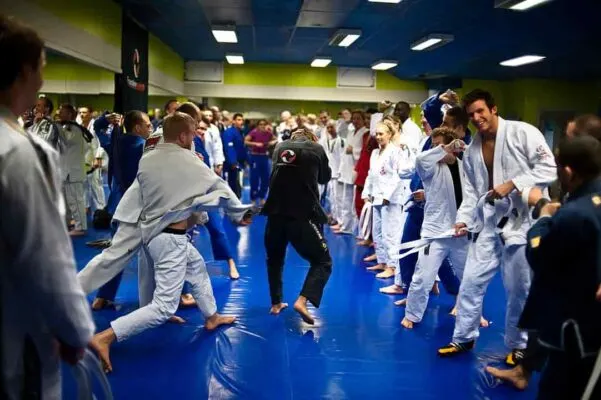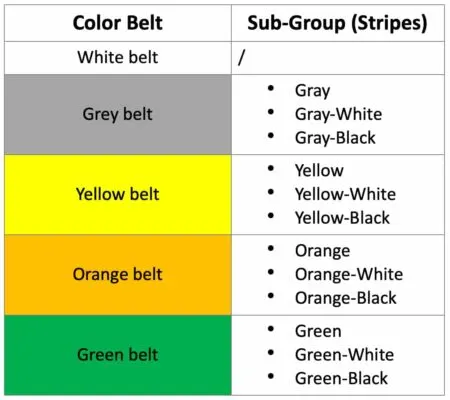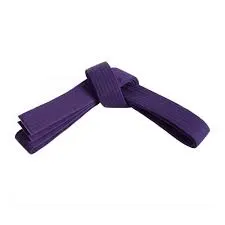
Brazilian Jiu-jitsu (BJJ) students are split into different ranks based on level of skill and experience, and each rank is presented with a solid-colored belt. They start as white belts and must be promoted through five additional ranks until they reach a black belt. But how does BJJ belt promotion work?
BJJ instructors are in charge of promoting their students. As a result, BJJ instructors will consider three main factors when promoting their students: their technical skills, how hard they work, and how well they do in competitions.
This is just a brief explanation of how BJJ belt promotion works, so be sure to read this article to learn about it in more detail. Let’s start with a short explanation of how the BJJ belt ranking system works.
Understanding the BJJ Senior and Junior Ranking Systems
The BJJ belt ranking system is split into two different age groups: seniors and juniors. Both groups include five belts each, and there are additional sub-ranks within each color belt called “stripes.” Here is the explanation for both.
Youth belts (Junior)
The youth belt ranking system includes five different solid-color belts: white (beginner), grey, yellow, and green. Each solid color belt consists of three sub-ranks (stripes): white, black, and the color belt. Youth students can’t move into senior ranks until they reach 16 years of age.

Senior belts
BJJ senior ranking system consists of five different solid color belts. There are four additional sub-ranks within each belt (stripes). Once a student reaches a black belt, there are six additional black belt ranks for levels 0–6, and three red belts for levels 7 to 10. Here is how it all looks in a table:

Who Can Promote Belts in BJJ?
The general rule is that a 2nd-degree black belt is allowed to promote students to black belt ranks. A 1st-degree black belt is enabled to promote students as high as the brown belt. There is a strict rule when it comes to who is authorized to promote students in each BJJ school. Before being able to promote students up in rank, the instructor must be certified by the IBJJF, which is a major BJJ governing body.
However, there are remote towns where BJJ academies do not have an experienced black belt who is most eligible to promote students. Brown belts can promote students up to purple belts in this case, while purple belts can promote up to blue belts. But all of these non-black belt practitioners must first be recognized by the IBJJF or other BJJ governing bodies.
Unlike in other Asian martial arts such as Taekwondo or Karate, there is no official testing organized by the governing body where you have to perform in front of a board of examiners. No, your head coach’s subjective judgment alone, and no one else’s, determines your promotion in BJJ.
BJJ belt promotion requirements and time frame (belt-by-belt)
White belt

White belts are reserved for beginners who have yet to learn the basics of BJJ. The beginnings of jiu-jitsu are often seen as harder than in most other martial arts, as students get thrown “into the fire” right from day one.
In the opening months, you will get submitted hundreds of times, leave the gym exhausted on all fours, and have a hard time staying motivated, consistent, and dedicated. But this is a part of the journey and why white belt levels are considered the “hardest.”
Blue belt

Blue belt is where students transition from the basic to intermediate levels of BJJ. The concept of training and techniques remains very much the same. But training becomes more serious, faster, and intense. It is also a level where it is expected of you to start working hard on improving your strength and conditioning and becoming more flexible and agile in order to perform techniques with better form.
What are the requirements to get a BJJ blue belt?
Skill-wise, white belts must focus on learning the basic principles of defense to become blue belts. They must know the basics of stopping a takedown and the procedures for escaping certain positions. When it comes to offense, you must know how to properly apply submissions like an armbar, triangle, and kimura and get into dominant positions such as mount and back mount.
Remember, you don’t have to be a master at executing these moves in a split second. The emphasis is on having a basic understanding of body mechanics, motions, and procedures.
How long does it take to get a blue belt?
A dedicated student with average talent and fitness may expect to receive a blue belt after 1.5–2 years of consistent training. Students who come into BJJ from conceptually similar martial arts such as Judo and wrestling, on the other hand, may need less time because they are already familiar with the basics and can progress more quickly.
Purple belt

Purple belts are already established grapplers with the ability to chain techniques together in a sequence. During the roles, they begin to think ahead, develop a plan and strategy, know how to stay calm, and have good timing.
For example, blue belts will wait for an opponent to make a mistake and create an opening. Purple belts, on the other side, create openings by themselves. This is also a stage where performing with clumsy technique and making some beginner mistakes is no longer tolerable by the coaches.
What are the requirements to get a purple belt?
Blue belts must focus on mastering all the fundamentals to perfection before moving on to the purple belt. They must have a solid understanding of all the basic positions and the ability to escape from the bad spots against resisting opponents. They also must have the ability to attack and apply submissions.
Overall, the key goal is to perform with better technique and show a methodical approach to BJJ. At this stage, most students start competing in local tournaments, and the results are also an indication of your progress.
How long does it take to get a purple belt?
On average, students need between 2 and 4 years of consistent training at the blue level before they can be promoted to the purple rank.
Brown belt

At this level, a BJJ practitioner has already mastered all the fundamental aspects of BJJ. They start perfecting their own style and rely less on utilizing sheer force during the rolls. Instead, their game has reached a level where they can win against bigger and stronger opponents by overwhelming them with high-level technique.
This is also a level where students need to spend more time on the mats, be as dedicated as possible, and do more intense workouts. As advanced practitioners, brown belts also assist the main instructors in teaching classes. They are usually teaching students below their rank and slowly getting into the coaching role.
What are the requirements to get a brown belt?
There are no specific technique requirements or strict criteria to meet in order to obtain a brown belt. Instead, you must show the coaches that you are serious about your journey and begin developing your unique style. Or, in other words, learn how to maximize your strengths and minimize your weaknesses.
At the same time, you must show the ability to be creative, think fast and find solutions when things are not going your way.
How long does it take to get a brown belt in BJJ?
On average, students need between 2–3 years of consistent training at the purple level before they get promoted to the brown belt rank.
Black belt

Experiencing a head instructor wrap a black belt around your waist is the dream of every BJJ practitioner. It is the ultimate reward for almost a decade of learning, pain, injuries, sweat, sacrifice, blood, and even tears. But it does not represent the end of the journey. In fact, reaching a 1st-degree black belt represents the birth of a new life according to BJJ philosophy.
BJJ Black belts have a strong understanding of each technique and the ability to recognize patterns in a blink of an eye, both when it comes to offense and defense. Apart from having a high level of technique, black belts know how to pass down the knowledge, explain how and why each technique works to the slightest detail, and help their students grow.
What are the requirements to get a black belt?
Despite developing your own style, you still need to focus on expanding your knowledge and mastering the art of jiu-jitsu. You must complement and improve your game by adding more complex moves and combinations. In addition, you represent your gym in tournaments, possibly winning medals, and also dedicate yourself to becoming a leader in classes.
How long does it take to become a black belt?
In most schools, students need to spend between 2 and 4 years as a brown belt before they can earn a black belt rank. To sum it all up, this translates to 10–15 years of consistent BJJ training in total to go from a white belt all the way up to the black belt rank.
| Color belt | Time to get | Total time |
| White belt | / | / |
| Blue belt | 1.5-2 years | 1.5-2 years |
| Purple belt | 1-4 years | 4.5-6 years |
| Brown belt | 2-4 years | 6.5-9 years |
| Black belt | 2-3 years | 9-15 years |
What does the BJJ promotion ceremony look like?
In most BJJ academies worldwide, the belt promotion is informal, so there is no “official” ceremony. In most cases, the main instructor will ask all students to gather around, ask a student who gets promoted to stand up, and present them with a belt rank.
But the coach will always do their best to make it special for you. They will dedicate a few minutes to talking about your progress and how they see your BJJ journey.
In some other schools, your partners from your group will form a line and congratulate you on your new achievement by slapping you on the back with their own belts. These small types of commemorations vary between gym cultures and the way they see promotions.
Do you have to compete to get promoted?
No, BJJ students do not have to compete to reach higher ranks, nor their progress is based on the competition results. The main reason is that BJJ is not rooted in competition but in self-defense. The system focuses on the practical application of techniques in real life, not in a controlled environment under strict rules.
So, the BJJ promotion is based on various factors, such as:
- The knowledge and progress you made
- How dedicated and consistent you are
- Your contribution to the art of jiu-jitsu through teaching classes or hosting seminars
- Other aspects are strictly related to BJJ training, not competition.
For example, an elite coach such as John Danaher never competed, but he’s a world-class coach. He has earned the 6th degree BJJ black belt due to his genius-level understanding of BJJ. His contribution to the sport far outweighs any gold medals he could have won in competitions. Coach Danaher consistently produces world-class BJJ competitors like Gordon Ryan.
What happens if BJJ students don’t get promoted?
The belt rank is a reflection of your progress and experience. If you don’t get promoted when you think you should, it is most likely because you still need to work on improving your game. Or maybe you got stuck on your journey.
Either way, it’s about yourself. You should focus on yourself, evaluate your approach to training and where you are at, reset your goals, and work even harder.
And yes, it can be frustrating to see someone who started their BJJ journey at the same time progressing faster. But don’t be subjective and accept the fact that the progression is based on many factors. They don’t even have to be more talented than you are; just being more dedicated and hitting the gym more often is enough for them to progress faster.
Can you skip belts in BJJ?
Technically, if you are really good and talented, you can skip belts in BJJ, but this does not happen that often in most schools. This is because most schools prefer to promote students one belt at a time, and each student must wear a belt for years before earning a higher one.
However, there are some minor cases where a new student can immediately get a blue belt or even a purple belt.
For example, a long-time judo black belt who transitions to BJJ is superior in skill, strength, and conditioning and understands the principles of BJJ far better than other beginners. Judo is a precursor to BJJ, and these two martial arts share a lot in common in terms of techniques, especially when it comes to throws, and require very much the same type of athleticism.
So, judokas who train for a few months can easily move up to a blue or purple belt.
Related Questions
Is there a fee for BJJ belt promotion?
Most BJJ schools do not include any fees for belt promotion. In contrast with other martial arts, there is no official testing in BJJ, where a board of examiners promotes students to higher ranks. Apart from possibly purchasing a $15 belt when promoted, there are no other costs.
In most schools, you have “earned” your promotion through hard work, dedication, and your contribution to the art of jiu-jitsu.
However, you may run into some schools that charge between $100 and $200 per belt promotion. Bear in mind that these are the red flags, and you should avoid training in this gym and search for another one.
